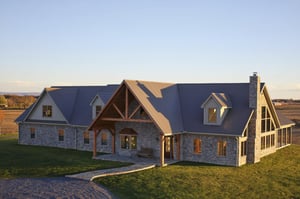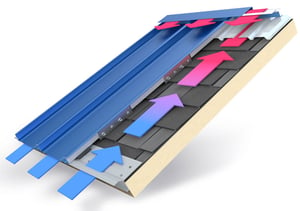Are Metal Roofs Energy Efficient?
Maximizing the energy efficiency of your home is a growing trend for many reasons. Using less energy to heat and cool your home saves on your carbon footprint and your wallet.
Energy efficiency is defined by the Office of Energy Efficiency & Renewable Energy as “the use of less energy to perform the same task or produce the same result.”
The ethical decision to lower your energy consumption minimizes the burden on the environment and contributes to a growing movement to turn attention and resources to more sustainable practices. Reducing your energy usage also positively impacts your budget.
To assess the financial benefits of a metal roof, we look at first cost and life cycle cost.
As you might guess, “first cost” refers to your initial investment when purchasing a product. In contrast, life cycle cost is how much the project will cost during the duration of its life expectancy for things like repairs, maintenance, and even quicker replacement. It’s important to consider both types of costs in any cost comparison because less expensive products are often prone to shorter life expectancies, maintenance, and repairs, which can ultimately make them more expensive than other options.
Case in point: consider a metal roof vs. shingles. Metal roofing may cost more initially, but with a life expectancy 3x that of shingles, a metal roof is usually the least expensive roof you can buy. Additionally, metal roofing offers much less maintenance and potential energy savings. When viewed through this long-term life cycle lens, the cost-benefit clearly favors the metal roof!
Adopting a sustainable mindset yields many benefits for consumers and the planet, and choosing an energy-efficient metal roof is a great first step. Read on to learn more.
Is Metal An Energy-Efficient Material?
 Yes! Metal roofing is highly energy efficient because it reflects heat up and away from the structure. In addition to the reflective tendencies of metal roofing, cool roof pigments and above-sheathing ventilation (ASV) are also critical factors in the energy efficiency of metal roofing.
Yes! Metal roofing is highly energy efficient because it reflects heat up and away from the structure. In addition to the reflective tendencies of metal roofing, cool roof pigments and above-sheathing ventilation (ASV) are also critical factors in the energy efficiency of metal roofing.
1. Cool Roof Pigments
Coatings on the metal panels play an essential role in the performance. Because metal roofing is continually exposed to nature's elements, care must be taken to ensure the selected coating system matches long-term performance and aesthetic expectations.
Metal roofing is available in a beautiful range of colors and finishes. You can also find a variety of paint systems on the market for metal roofing (some better than others). Advances in paint technology enable manufacturers to add reflective pigments to their paint systems, increasing the already existing reflective properties of the metal panel itself. Metal roofing coated using paint systems with reflective pigments is referred to as cool metal roofing.
Cool metal roofing is defined as having high solar reflectivity and high thermal emittance. Reflectivity is the measurement of the amount of energy reflected away from the surface of the roof. Thermal emittance, on the other hand, is the measure of a panel’s ability to release heat that it has absorbed. These two factors work together to decrease the amount of the sun's energy that the roof absorbs. This means less heat enters the roof system, the attic space, and the rest of the home, which lowers the interior temperature and the utility load. And we aren’t talking about an insignificant reduction in the use of utilities - studies have shown that a cool metal roof can lower cooling energy costs by as much as 20%.
Another important factor to consider is the impact of color choice on your roof’s cooling potential. Did you know that lighter colors reflect the heat and keep the building cooler than dark colors? While light colors are optimal for reflectivity, even darker metal roofs still offer better reflectivity than shingle roofs.
2. Above Sheathing Ventilation
 Above-sheathing ventilation (ASV) is another way to make a metal roof more energy-efficient and lower utility expenses. ASV adds a ventilated airspace between the roofing material and the substrate below. This airspace allows energy to move through the space and vent back into the atmosphere rather than being absorbed by the building.
Above-sheathing ventilation (ASV) is another way to make a metal roof more energy-efficient and lower utility expenses. ASV adds a ventilated airspace between the roofing material and the substrate below. This airspace allows energy to move through the space and vent back into the atmosphere rather than being absorbed by the building.
ASV can have a huge impact on the amount of energy that gets absorbed into the home. This is especially true for areas that experience extreme heat, like in the video below, where ASV and solar venting kept an attic a cool 5 degrees warmer than the ambient air. Compare that to an attic with only shingles on the roof, which was almost 40 degrees hotter than the ambient air.
Is Metal An Environmentally Friendly Material?
Again - yes! Increased energy efficiency isn’t the only eco-friendly advantage of metal roofing. Metal roofing can last 60 years or more with little to no maintenance, saving on production energy, minimizing waste, and saving building owners thousands in repairs and replacements.
Metal roofing is 100% recyclable, leaving virtually no waste behind.
Is Metal Suitable For Recovering My Existing Roof?
Yes, it is! Metal is an excellent choice for recovering an existing roof and an inherently sustainable option. Recovering an existing roof is an energy-efficient choice for several reasons. First and foremost, recovering a shingled roof eliminates the need to remove and dispose of the original roof, reducing pressure on landfills. Secondly, recovering an asphalt shingled roof with metal reduces labor, new materials, and installation time. It also minimizes the need for repairs and maintenance for the next 50 years. Finally, leaving the existing shingles and substructure in place provides additional insulation from heat, lowering long-term costs.
Is Metal A Good Fit With Solar?
Absolutely! Solar panels are an increasingly popular way to create sustainability in individual homes and businesses, and metal roofs are perfectly suited to pair with solar panels. Unlike shingle roofs, which require the drilling of holes during solar panel installation, metal panels attach without penetrating the roof, keeping the roof (and the warranty!) intact. Additionally, metal roofing is strong enough to withstand the extra weight of solar panels, and its long lifespan means your solar investment will benefit you for decades without interruption.
Is Metal The Right Material For Your Project?
Investing in a metal roof means decades of lower utility bills, increased energy efficiency, and minimal maintenance. If you are seeking the perfect way to increase your home’s energy efficiency while saving dollars and the planet, metal roofing might just be the choice for you.
About McElroy Metal
Since 1963, McElroy Metal has served the construction industry with quality products and excellent customer service. The employee-owned components manufacturer is headquartered in Bossier City, La., and has 14 manufacturing facilities across the United States. Quality, service and performance have been the cornerstone of McElroy Metal’s business philosophy and have contributed to the success of the company through the years. As a preferred service provider, these values will continue to be at the forefront of McElroy Metal’s model along with a strong focus on the customer.



.png?width=767&name=Metal%20Roofing%20for%20Event%20Centers,%20Arenas%20%20&%20Sports%20Facilities%20(1).png)

.png?width=767&name=Barndominiums%20and%20Shouses%20Designing%20for%20Modern%20Living%20with%20Metal%20Components%20(1).png)



Comments on this article:
Scroll down to the bottom to submit a comment and join the conversation. Need help or have a question? Please contact us. Looking for a distributor or contractor? Please click here to get started.